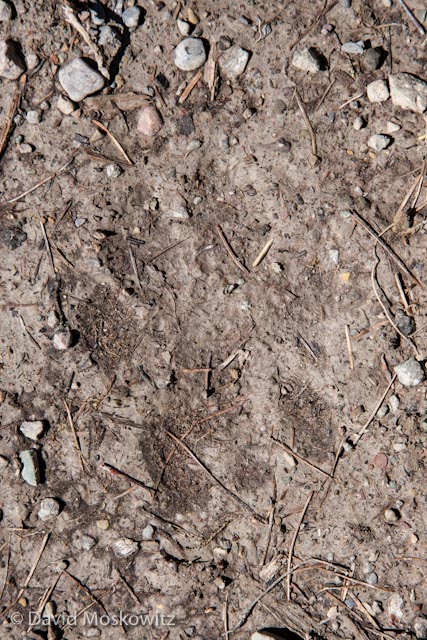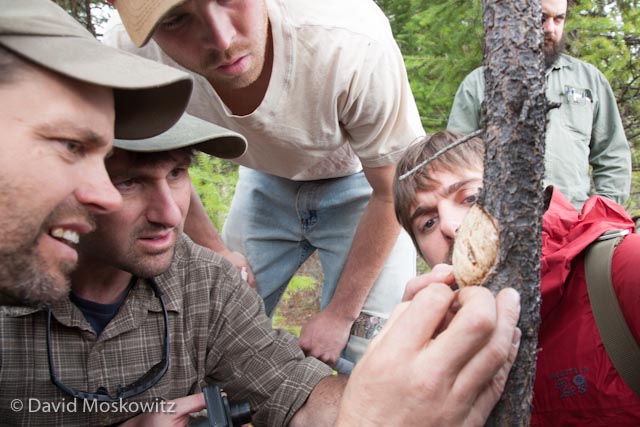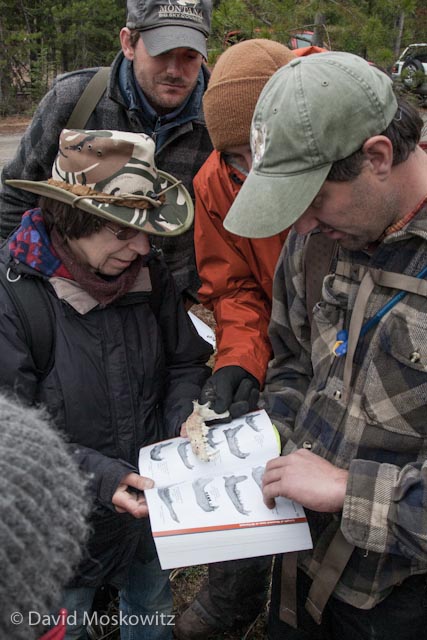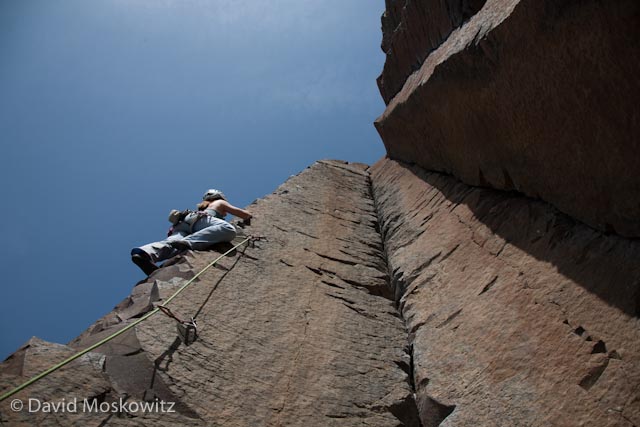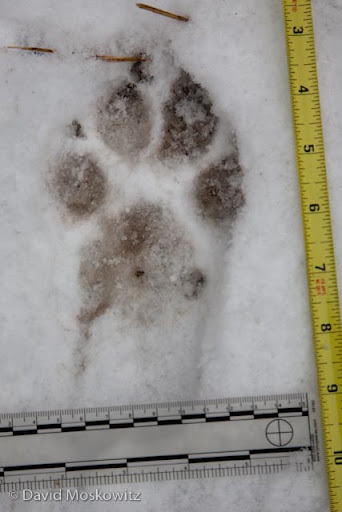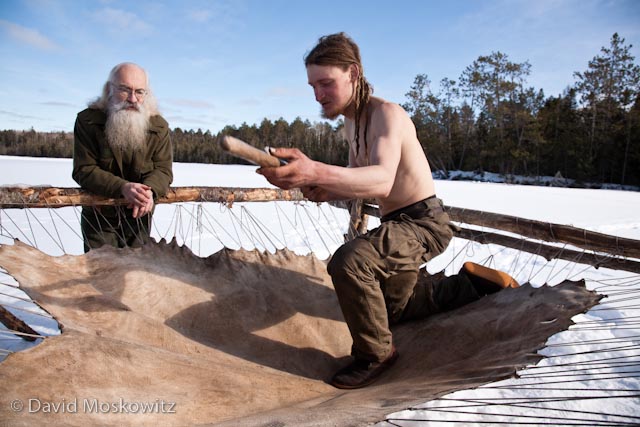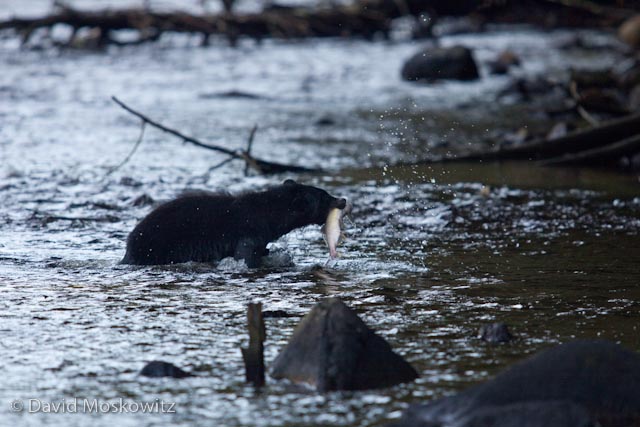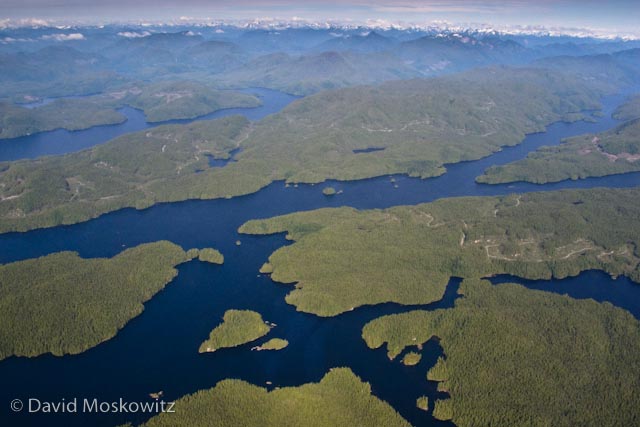While scouting for teaching locations for the Wildlife Tracking Intensive at the end of April, Alexia Allen and I spotted a small rodent moving through the leaf litter in a riparian forest close to the Hoh River on the west side of the Olympic Peninsula. I quickly reached down and captured the little grey creature who was kind enough to pose for a few photographs!
Cybertracker Conservation Track and Sign Certification Event in the Swan Valley, Montana
Senior Tracker and Evaluator Mark Elbroch points out some of the finer details of a track during a discussion of one of the questions on the Evaluation.
Congratulations to all 11 folks who participated in the Track and Sign Certification Event in wild Swan Valley of northwestern Montana this past weekend, all of whom earned a certificate through Cybertracker Conservation!The event was hosted by Northwest Connections in the very quiet town of Condon. It was great getting to know more about this creative and inspiring organizaiton whose mission to "Integrate Science, Education and Community in the Conservation of Rural Working Landscapes". I highly recommend any and all of the various educational opportunities they have to offer and hope to be back there soon! A special thanks also to Nick Sharp, Wildlife Conservation Society Biologist, and Doctoral student at the University of Montana, who organized the event (and put in a stellar performance on the Evaluation!)Over the course of the two days of the Evaluation, participants were given 70 different questions about tracks and signs discovered in the field. Species varied from voles to grizzly bears and the handiwork of everything from a bushytailed woodrat to a backhoe. Along with covering as diverse a set of tracks and signs as is possible over two days, the evaluation includes questions ranging from very simple (such as a clear deer track) to very challenging (such as interpreting the behavior of an elk which had scraped bark off of the trunk of an aspen with its incisors). For more information on Cybertracker Conservation Wildlife Tracking Evaluation methods click here.
Senior Tracker Brian McConnell, who assisted in delivering the evaluation, points out one of the questions, marks on an aspen tree to Adam Lieberg, Conservation Program Program Coordinator at Northwest Connections. Adam correctly interpreted them to be made by a black bear which had climbed the tree.
Here are photos of some of the things that were on the Evaluation and the questions about them. All questions are based on actual tracks and signs discovered in the field by evaluators during the Evaluation. After all of the participants have the opportunity to answer each question, the track or sign is discussed as a group and the evaluators carefully explain the correct answer and discuss why it could or could not be various other species, often using illustrations and other resources to help illustrate key features.
Interested in participating in a Certification Event or hosting one? Find a list of future events I am running at davidmoskowitz.net. Our North American website for all Tracking Certification events is currently underconstruction. Send me an email if you want to discuss details on hosting an event or links to Certification Events in other parts of the country!
Pulling Down At Frenchman Coulee
Thanks to Erin Smart and Forest McBrian for putting up with a lens in their direction during a beautiful couple of days of climbing in Frenchman Coulee in Eastern Washington.
Wolf Tracking In Wisconsin
Just home from a week and a half of adventuring in northern Wisconsin where I participated in a collaboration between Teaching Drum Outdoor School and Wilderness Awareness School on Wisconsin Wolf Tracking Expedition, joined by former Wilderness Awareness School Instructor and founder of the Earth Native Wilderness School, David Scott. Teaching Drum hosted the program which was held very close to the School's home base near the town of Three Lakes, Wisconsin. Despite unseasonably warm conditions on several of the days and a lack of fresh snow for the first half of the class, snow conditions allowed us to peice together some amazing stories about the wolves of the region and the other wildlife that share the North Woods with them.
A Winter Day in Eastern Okanogan County
Went exploring in eastern Okanogan County a couple of days ago. A beautiful landscape and one hard to reconcile with Washington's tag line-"the Evergreen State".
Conservation Northwest Ocotober Newsletter
 The October edition of the Conservation Northwest newsletter is available online and features a number of images from my wolf project along with excellent articles on related topics! Downloaded it at: http://www.conservationnw.org/library/newsletter/newsletter-pdfs/Fall2011-CNWQuarterly.pdf
The October edition of the Conservation Northwest newsletter is available online and features a number of images from my wolf project along with excellent articles on related topics! Downloaded it at: http://www.conservationnw.org/library/newsletter/newsletter-pdfs/Fall2011-CNWQuarterly.pdf
View all of Conservation Northwest's Newsletters at: http://www.conservationnw.org/library/newsletter. The September edition also features a number of my images and excellent related articles.
16-20: The aroma of rotting salmon
Spent 4 of the last 5 nights out in the field, attaining a sense of oneness with the river, the tides, the migrating salmon, the moss and lichen cloaked trees of the rainforest, the bloodthirsty blackflies, and the ever present aroma of rotting fish carcasses--the good life. Several interesting encounters with wolves which I'm sure will make it into the book.Flying south tomorrow and home the day after. Now that all the field work is completed, I reckon I'll be chained to my computer for the next month and half writing. Don't think I'll be posting daily updates.
15: Getting teased like a raven swooping on a wolf
The remains of a very recent meal of some rainforest wolves on the British Columbia coast.
A raven taunts a wolf in morning fog.
Heavy fog slowed our arrival at field sight. We likely scared them out of the stream when we showed up. Found a ton of headless salmon and a couple laying the grass still flopping. Got a few images of one animal. Heading back out this evening to camp for a few nights in an attempt to be out there at first light without disturbing them! Wish me luck! May be a few days before my next post.A raven taunts a wolf in morning fog.
Day 14: They come in the night
Well, we were right to be hopeful. The wolves came. And the wolves caught and ate salmon. Right in the stream in front of the blind were we were set up to photograph. During the night between when we left at sundown and before we arrived at first light. We did watch one wolf skirt the edge of the meadow we are set up on later in the morning but didn't take any photographs.When we left the pink salmon were literally streaming into the mouth of the creek on the rising tide so we will see what tomorrow holds!
12/13: Go for the eyes
A raven pecks out the eye of a recently expired pink salmon in a shallow stream on the British Columbia coast.
Rain, wind and looming deadline for three chapters of writing kept me in yesterday. Today Doug and I spent most of the day in the location we photographed the pups a week ago. Tons of pinks in the river and we heard howling just as we were packing up to leave at dark. Optimistic about tomorrow!Find out more about my project on Wolves in the Pacific Northwest!
Two men dwarfed by the rainforest they are about to enter. They were out counting fish carcasses along the stream to determine the number of salmon returned thus far for the Heiltsuk Nation’s Fisheries Program.
11: A not so great bear
A young black bear makes its way across a coastal stream in the Great Bear Rainforest.
A long day sitting along a river here in the Great Bear rainforest trying to stay dry and not get eaten alive by bugs. The only large mammal out and about today besides us was this yearling black bear which poked around in the river briefly before nearly walking into my blind before I said hello and it ran off into the forest.On the way back in the evening we passed an absolutely massive barge carrying a huge amount of timber heading. Hard to tell from this image but the barge is multiple stories tall. Bet the bears where those logs came from are having a worse day than the fellow who ran into me this morning.To find out more about conservation issues related to the Great Bear Rainforest visit Raincoast Conservation Foundation's website at www.raincoast.org
Tug pulling a barge loaded with rainforest trees, dwarfing a fishing vessel to the right.
Day 10: Of fish and bird
Doug enjoying a cup of coffee during the morning commute to the office.
Got 18 species on my bird list for the day including two new ones for the life list, a Black Turnstone and a Surf Bird. Lots of salmon in the streams we visited but the wolves have continued to be scarce.
The Office
The only sign of wolves we found today were a couple of brainless chum salmon.
Chum salmon swimming upstream.
Jumping Coho salmon
Black turnstones
Day 9
View from my blind.
Dinner
A beautiful morning on the same stream I've been at for the past several days. The only wildlife activity was a tiny shrew that scampered in front of my small blind before disappearing into the tall grass. No salmon in the section of stream I was set up on today. Doug's dad, a commercial fisherman had a slightly better catch today, (about 26,000 pounds of salmon better) so I won't be going hungry tonight.
Day 8: Why I am up here for 21 days
Shearwater Fuel Dock. Featuring gasoline, diesel, and a slot reserved for floatplanes.
Rain all morning and wind along with a vey high tide kept me out of the field all day. Luckily I was able to explore the small town of Shearwater, home to a lovely fuel dock and a pub that has a pretty good Pale Ale on tap at the moment.Find out more about my project on Wolves in the Pacific Northwest.
And on the 7th day he rested
Spent the day catching up on sleep and writing. Actually enjoyed not lifting my camera once today. Back at it bright and early tomorrow.
Day 6: Sick of listening to ravens
One of the many ravens lingering along a salmon bearing stream and feeding on the remains of coho killed the day before by wolves.
Spent much of the day back in the same location as yesterday. No wolf activity but the ravens and eagles where quite active further upstream. After three hours of sitting in my makeshift blind I wandered upstream to see what was so interesting and discovered the remains of about a dozen coho that had been killed by wolves the day before (likely around the time we were photographing the pups).For some more images of the area check out the awesome photos of Douglas Brown at his website: www.douglasjbrown.com
More info on my project at: davidmoskowitz.blogspot.com/2010/03/wolves-of-pacific-northwest.html
Day 5: Puppies!
Three curious wolf pups in a wet meadow.
Doug and I walked into a area where he has found wolves fishing for salmon in past years to see if there were fish running in the stream yet. Apparently we weren't the only one's curious about it!
Two ravens discussing the morning’s events.Learn more about my project on Wolves in the Pacific Northwest!
Day 4: Quiet day on the water
Calm morning water on an inlet north of Bella Bella
Jumping chum salmon are a common sight in the still waters close to fresh water streams at the moment
Day 3: Salmon are spawning!
Spawned out chum salmon in a small stream in the Great Bear Rainforest.
Chum salmon carcass with the top of the head removed by a wolf and a fresh wolf scat besides it.
We discovered a stream in an inlet northeast of Bella Bella today in which the chum salmon have started moving into and spawning. Along the banks close to the mouth we also discovered about a half dozen carcasses that had been fed on by wolves and a couple of fresh scats.
Learn more about my project Wolves in the Pacific Northwest.
Great Bear Rainforest Day 1-2
View from the flight into Bella Bella-a maze of rainforest clad islandsand wandering ocean inlets bounded by the Coast Range to the east
View from the water on my first day out in the field
Doug Brown, the field station manager for Raincoast Conservation Foundation,and my guide, spotted this wolf along the shore of a small island northeast of Bella Bella.
.
Sunshine and wolves greeted me on my first day in the field here on the central coast of British Columbia. The salmon are gathering at the mouths of the creeks and rivers here.Learn more about my current project on Wolves in the Pacific Northwest!








